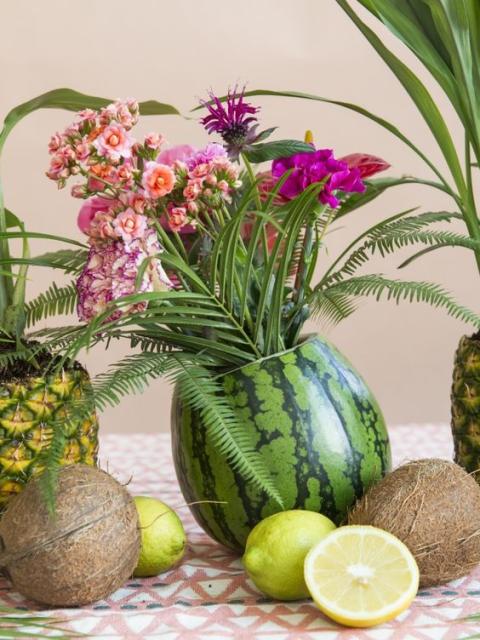Delphinium: characteristics and flowering
Delphinium, also known as larkspur, is a spectacular flower that stands out for its tall, elegant flower clusters that rise enthusiastically above everything else in the garden. Delphinium's flowers have a bright, often blue, colour. They come in shades of soft blue, bright blue, medium blue and lilac blue, as well as white, yellow, purple, red, pink and two-coloured varieties. You can also choose between single-flowered delphiniums (with a single row of flowers around the bud) and double-flowered delphiniums (with double flowers around the bud). The stem with flowers can be 30cm to 250cm long.
Delphinium is part of the ranunculaceae family (Ranunculaceae), which also includes flowers such as ranunculus, anemone and akelei. Larkspur usually blooms in June and July, and there may be a second flowering in August and September. During flowering, the petals fold completely open, displaying their bright colours. Flowering lasts from a few weeks to a few months, depending on care and conditions. An additional advantage is that butterflies, bees and bumblebees also love delphiniums, making them a biodiverse-aware pick.
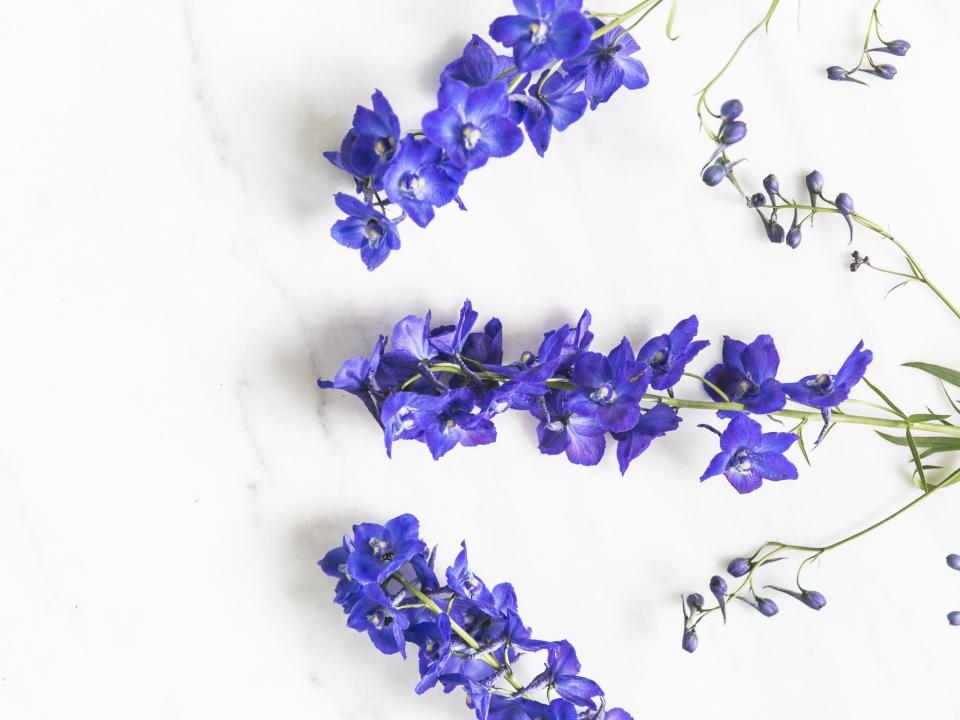
Where does the name delphinium come from?
With a little imagination, you can see that the buds of the flower look like dolphins. Hence the name delphinium, the Latin word for dolphin.
What types ofdelphiniums are there?
There are around 300 species of delphinium, which can be divided into several main species. The species/cultivars of delphinium below are the best known:
- Delphinium Belladonna: this species, also called ‘delicate delphinium’, stays relatively low to the ground, only growing up to a metre high, and has an open flower structure, giving the flowers an airy, open appearance. Belladonna has a more delicate, subtle appearance than the other species of delphinium. Colours of this species range from various shades of blue to lighter shades of pink and lavender.
- Delphinium Elatum: This species, also called the common delphinium, grows taller than the Belladonnas (up to two metres). Colours range from blue to purple, pink, white and lavender. The heart of these flowers is black, distinguishing this species from the others.
- Delphinium Grandiflorum: this species, also called Chinese delphinium, is known for its beautiful flowers in loose clusters. The stems stay relatively low (40-60 centimetres) and the flowers are smaller than those of Pacifics and Belladonnas. Flower colours range from blue to purple, pink and white.
- Delphinium Pacific: this species is known for its impressive height (up to 2-2.5 metres), very large flowers and dense flower spikes. Colours of this species range from various shades of blue to purple, pink, white and lavender.
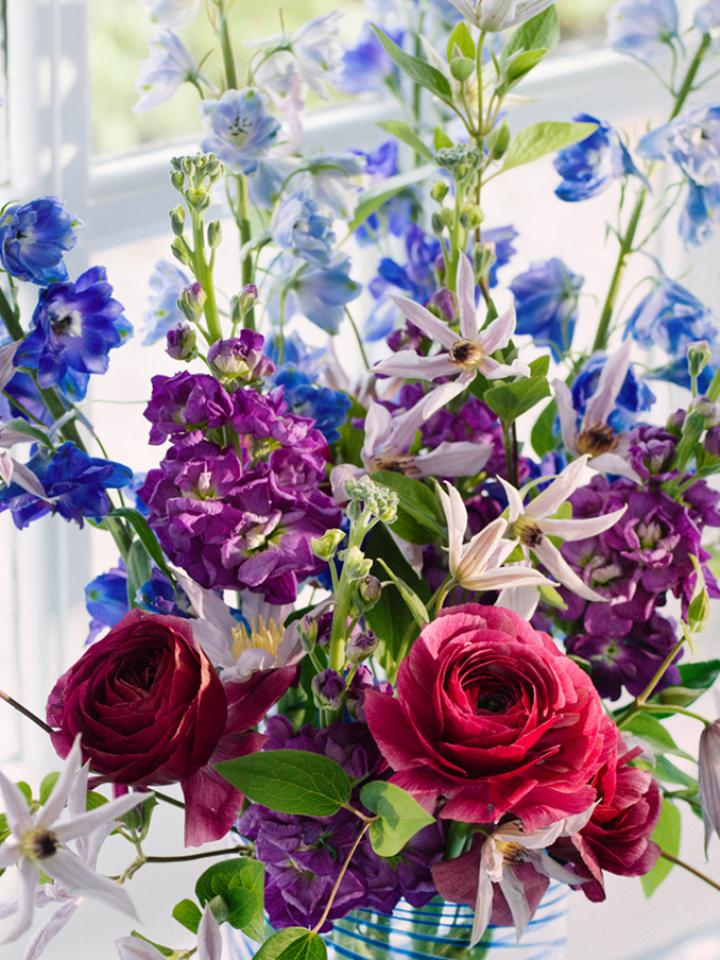
How to take care of cut delphinium in your vase
These blooms look great as both a mono-bouquet made up solely of delphinium, or as part of a mixed bouquet. These tips and tricks on how to keep these flowers looking beautiful for as long as possible will help to expand their lifespan.
- Cut the stems of Delphinium diagonally with a sharp, clean knife.
- Put delphinium in a clean vase with clean water at room temperature. Tip: As delphiniums have fairly long stems, preferably you should choose a slightly taller vase so that the flower panicles are less likely to droop.
- Add cut flower food to prolong the life of the flowers.
- Check often that the flowers still have enough water and change the water regularly.
- Do not put the flowers in a draught, in full sunlight, near the heating or next to a fruit bowl.
How to plant delphiniums in your garden
Larkspur is a real eye-catcher in a garden border and its long flower clusters give a vertical accent to planting. Most delphiniums are hardy perennials, but there are also annuals available. Have you chosen your colour and variety? Check out the following tips for sowing or planting delphinium in your garden.
- Larkspur should preferably be sown in spring (between March and the end of May), when there is no chance of severe frosts.
- If you already have delphinium in your garden, you can use the seeds from it. When your delphinium has finished flowering, wait until the seed capsules are completely dry. If you hold them upside down, the seeds will fall out. Store them in a paper bag in a dry, cool place and sow them next spring.
- Plant delphinium in spring or autumn, when the soil is warm and moist enough and the plant is more likely to grow and flower. If you plant the plant in spring, it may flower as early as summer. Want to know more about planting garden plants? See information, tips and step-by-step plans here.
- If you plant a cutting, choose either the Belladonna or Elatum varieties, as these are the hardiest and most colourfast varieties with the greatest chance of success.
- The average planting distance to aim for between delphiniums is about 45 centimetres. Low delphiniums may be planted closer together (around 35 centimetres) and for tall delphiniums you can leave a bit more space (around 50 centimetres). Annual delphiniums may be planted closer together (20-30 centimetres).
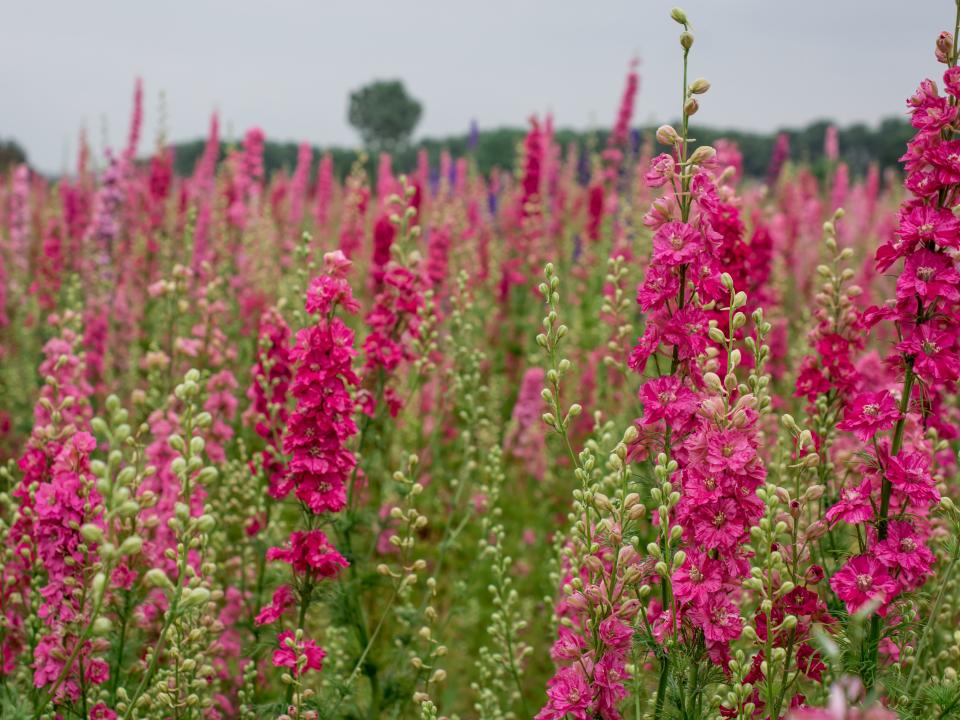
Delphinium in your garden: location and caretaking
Planning to plant delphinium in your garden, or are the flower clusters already shining in your outdoor space? Take a look at the tips below for inspiration on the location of the plants and how to take care of them:
- Larkspur thrives best in a spot in full sun. A spot in the semi-shade is also feasible.
- Make sure the soil is well-drained and permeable, preferably with a little lime added. You can improve the soil by adding compost or another organic fertiliser.
- Due to their long stems, it's wise to protect delphiniums from strong winds. A sheltered spot will help the flowers stay upright.
- Their height means delphinium often looks best at the back of a sunny border.
- You can support long panicles with sticks or plant supports to ensure that they stay upright and do not kink or break.
- Give delphinium organic fertiliser annually in early spring, to promote healthy and beautiful growth and flowering.
- Give delphinium some lime in winter.
- Make sure the plants aren't too dry in summer or too wet in winter.
- Water delphinium regularly during dry, warm periods. They like slightly moist soil but don't like to have wet feet, as this can cause root rot. Try to avoid using a sprinkler, as these can cause the flowers to fall over or lean.
- If you want to enjoy this plant for more than two years, transplant it. Delphinium doesn't like to stay in one place for several years, as it is sensitive to nutrient-poor soil and mould. For many species, it's wise to dig out the entire plant every two years. Do this before the growing season starts and in a frost-free period, preferably in late February or March.
- Larkspur is susceptible to mildew, a fungus. Mildew can be recognised by white or grey fungal fluff or spots on the leaves. If you notice mildew, use a biological control agent as soon as possible to combat this fungus and prevent the plant from dying.
- To prevent mildew as much as possible, make sure the plants aren't too close together and water the them near the soil, not on their leaves.
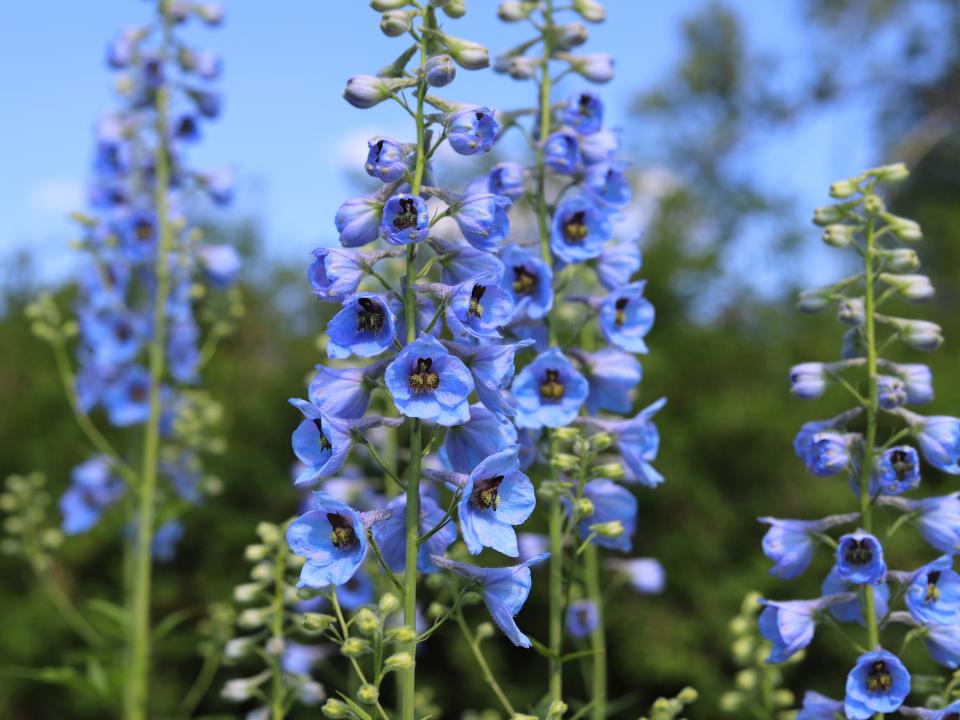
How and when should you prunedelphinium?
Has your delphinium finished flowering? With careful pruning, you can enjoy the beauty of their flowers twice a year. To do this, cut the spent stems far back after the first flowering to just above the ground. Side shoots and remaining leaves growing from the base can be left in place. If necessary, add quick-release organic fertiliser and water. With a bit of luck, the delphinium will then flower a second time in August or September. When the plant has finished flowering after the second time (early autumn), you can cut it back to just above the ground.
Delphinium symbolism
This often-blue flower symbolises protection. Delphinium used to be considered a mystical plant and was used during rituals to ward off negative energies. It was also once thought that you could chase away scorpions with a Delphinium.
Protection is not the only symbolism attributed to this plant. In the past, the towering flower spikes also symbolised nobility, wealth and pride. Other symbolic meanings attributed to Delphinium are health, pleasure, lightness, levity and a big heart.
Delphinium origins
Delphinium is native to several areas in the northern hemisphere, including Europe, North America and parts of Asia. It has been popular since ancient times for its dainty flowers and spectacular appearance. In medieval European gardens, Delphinium was often cultivated for its towering flower spikes, which symbolised nobility and wealth. The popularity of delphinium continued to increase over the centuries and more and more cultivars were grown. Today, delphinium is a much-loved garden plant and cut flower worldwide.
Is delphinium poisonous?
Yes, delphinium is poisonous. All parts of the plant contain substances such as alkaloids that are highly toxic to humans and animals when ingested. Ingestion of delphinium can cause stomach upset, diarrhoea, digestive problems and skin irritation. Therefore, be extra careful in gardens where children and/or pets live and play. Always consult a vet or doctor after ingestion.

















